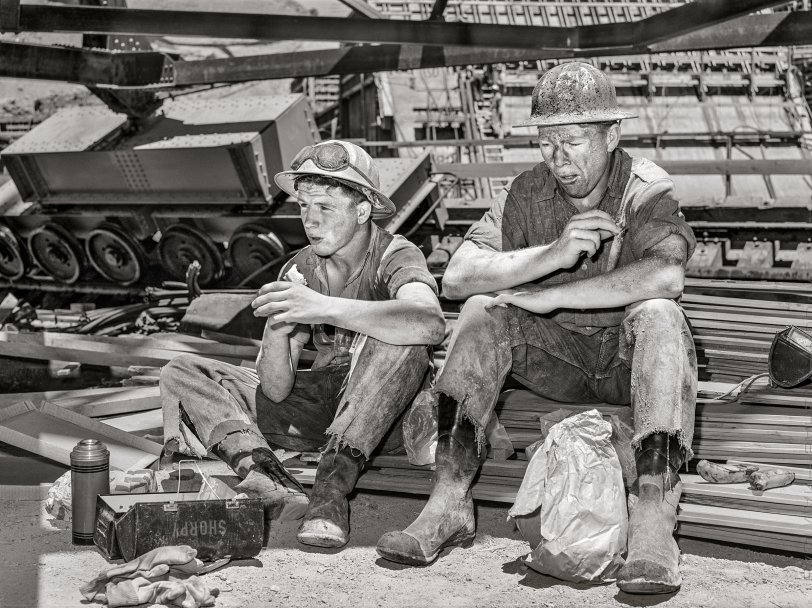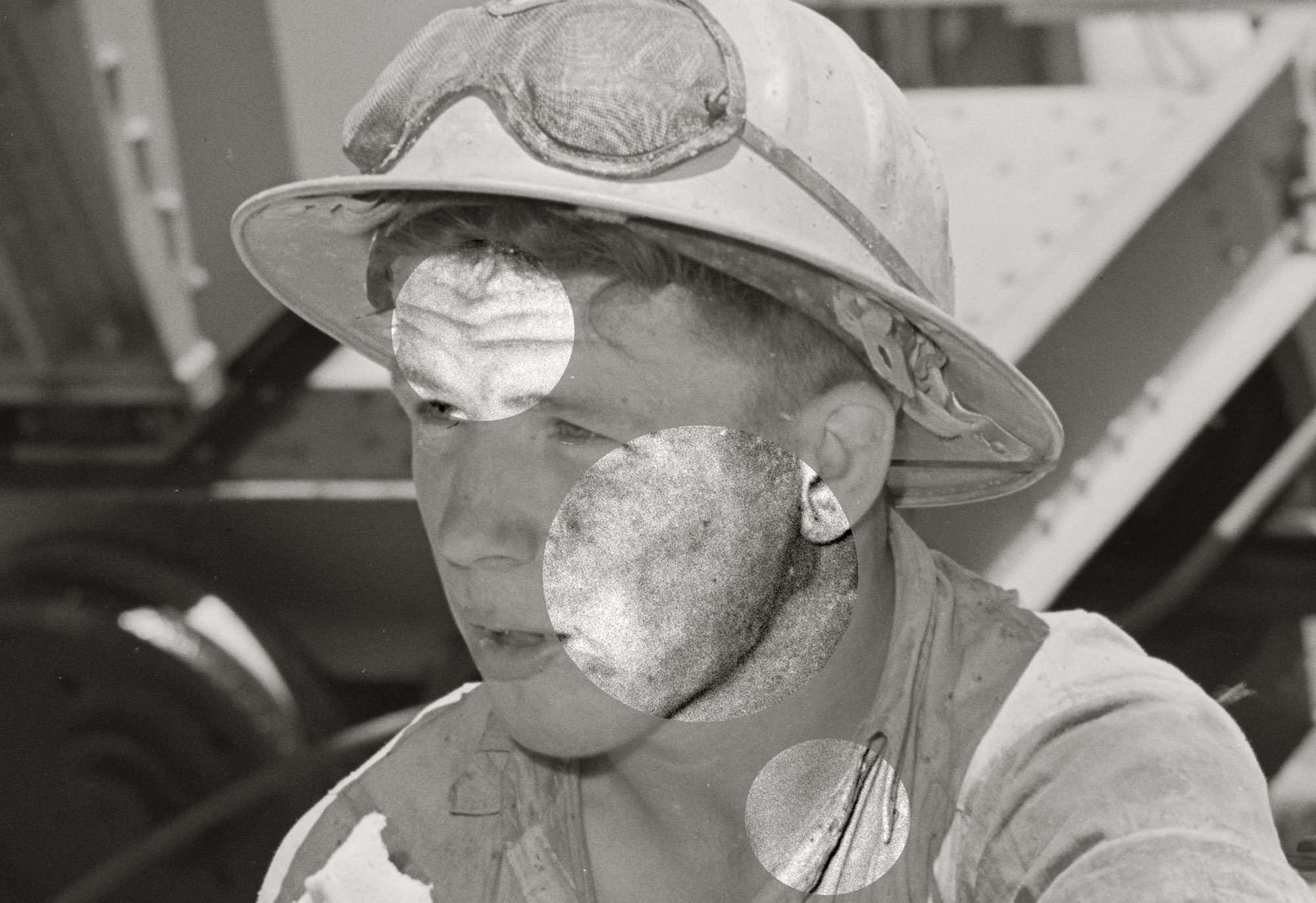


Framed or unframed, desk size to sofa size, printed by us in Arizona and Alabama since 2007. Explore now.
Shorpy is funded by you. Patreon contributors get an ad-free experience.
Learn more.

- Lofty addition
- In 1912
- Keenan Building
- Six years old
- Taken from the P.J. McArdle Roadway?
- It stood only 47 years
- Three track mind
- Incline to the right
- Reach for the sky, 1912 style
- No clean sweep
- Same Job Title, Same Face
- Sadly Lost
- Beautiful ...
- Where you get your kicks
- Aim High
- Pueblo Revival sisters
- Pueblo Neoclassicism
- Milk Man
- Regional dialect.
- Spielberg's inspiration
- Great Photo
- Loaf Story
- Do you still have the Rakes category?
- Could almost be a scene from the 1957 movie 'Hell Drivers'
- The Wages of Fear.
- Conspicuous by their absence
- Got Milk?
- All that aluminum
- No lefties
- Smoke 'em if you've got 'em
Print Emporium
Two-Banana Lunch: 1942

June 1942. "Shasta Dam, Shasta County, California. Workmen." Medium format acetate negative by Russell Lee for the Office of War Information. View full size.
Stagged Pants
Loggers and foresters know all about "stagging" pants cuffs. If you catch a hemmed cuff on something while walking through the woods, you are likely to take a very painful fall. If the pants are stagged, they'll more likely rip and you won't be as likely to fall. This is even covered in the Weyerhauser safety manual published in 1968:
"Pants shall be stagged off to prevent hangups from brush and limbs. Pant length is recommended at about four inched below top of “corks”. Pants shall be supported with suspenders while working on the rigging crew or cutting crew."
"Corks" are a type of working boot.
Mark (former forester wannabe who ended up in the nuclear biz)
Not just a pretty face
I love Shorpy's photos but I also love all the engaging and informative comments! Keep it up Shorpyites.
Heat exhaustion
Shasta Dam is located just outside Redding, well-known as the epicenter of hot weather in Northern California. These workers could at least try to find a spot of shade for their lunch break.
At this point in time, if they weren't employed here, they would likely have found themselves on a troopship headed for Guadalcanal, or North Africa, or some equally hot place. Or perhaps building the Alaska Highway, amid swarms of mosquitoes.
Cableway
Besides being of fantastic human interest, this photo shows an interesting engineering detail of the construction methods of the day. Behind the workers is one of the 4 massive "cars" supporting one of the aerial cableway towers, as seen in https://www.shorpy.com/node/26703, and many other big construction projects. The workers are sitting under the tower. There is one of these "cars" supporting each of the 4 tower legs. This shows that at least some of the cableway towers could be moved, to allow positioning materials and concrete wherever needed. The car sits on a pair of swiveling 6-wheel trucks, either to allow for minor misalignment, or to permit following curved track. Additionally, it looks like there is a heavy bar going down from the corner of the car to just above the far rail, as a backup. The visible track is very steeply angled, to withstand the immense pull of the long cableway spans. The tower leg rests on a swivel joint to allow for rotation of the car relative to the tower leg. Looking at the previous photo, it appears likely that the center tower in that photo doesn't move, but the multiple towers along the banks each move. There are 3 cableways visible going out in either direction from the center tower, thus 3 movable towers on each landside bank. There would need to be coordination to keep all of the cableways productive without conflict between the movable towers. For maintenance purposes, the draw works for each cableway are probably on the movable towers, and the center tower is just a strongback. Materials and cement would also be delivered from the landside.
Bananas and Genetic Diversity
It's likely that those bananas are of the Gros Michel variety. It was the most common banana in America, until it was wiped out by a fungus in the 1950s. Their lack of genetic diversity made bananas highly susceptible. Today, we eat Cavendish bananas, which are resistant to that fungus. The lack of genetic diversity remains, however, so some other fungus may wipe out the current population. Eat 'em if you got 'em.
Powerful flash?
That's an amazing photo. Part of why it's amazing is the detail in their faces, which is hard to photograph in direct sun. You would assume that there would be deep shadows on their faces, from their helmets... but there are no such shadows, and you can see every bit of dirt.
So there must have been a flash powerful enough to complete with the direct sunlight. Would that have a flashbulb? Did they make really big ones?
[The dirty details come to us courtesy of Photoshop 2022, and Dave 1958. - Dave]
John Wayne's buddy
The guy on the right reminds me of Ward Bond.
That's not a Twinkie
Like pennsylvaniaproud, I assume hardworking men like these wolf down large quantities of food. I know I did. I first thought the man on the right was smoking a hand-rolled cigarette, before eating his bananas, because of the way he's holding it. But he's not smoking. He's holding a tiny piece of food and appears to be taking very small bites. Either he's savoring every morsal or, less likely, forcing himself to eat something he doesn't like.
I want my Shorpy lunchbox in lime green, so no one can steal it.
They'll make a box of Twinkies nervous
And never gain an ounce.
Metal workers maybe?
The young guy on the left has goggles but his face and arms are too clean to be the lead worker. The big guy on the right has a very dirty face but you can see that he had goggles on by the white around his eyes, so he must have been up very close to whatever it was he was working on. I read that the full face welders shield or helmet came about in 1937. I think they could be involved with cutting metal either with a grinder or torch just before their lunch break and this photo. That would also explain the pant legs being cut off. You don't want to catch molten metal from welding or cutting and you don't want to catch flying sparks when grinding in the cuff of your pants.
Workers’ pant legs
They're not short, about ankle length when standing. Working in those conditions, muddy dirty, cloth tends to soak up any moisture so you don't want them too long.
“You know what, son?
Hard to believe, but in 80 years, folks will be paying $140 for a pair of jeans like these.”
Something Beyond Starched
Pants have a rather short life expectancy in large concrete pour projects. One might try to roll up the cuffs to minimize exposure to the wet pour. Or one beats the dried material off the leg bottoms, in hopes some flexibility may be restored. But inevitably an impasse is encountered--you've got the concrete bell bottom blues. The only solution (short of buying the next replacement pair) is to cut off the rigid material.
Merchandising
I love the new merchandise. When will it be available for general sale?
No Cuffs
That's a really good photo. It captures physical rest from dirty, hard work really well. It's the state of being when food tastes really good, just for the calories. (Those two bananas will be next, and greatly appreciated.)
I'm struck by both men (son and father?) wearing "cutoffs." All four legs of their jeans are shorn of their hems. What's that all about?
Also: Good work on the dam, fellas. Your hard work has served the state for 80 years now.
Frayed jeans
I work a job where we wreck a couple of pairs of gloves per week. Not a surprise. How did they fray their pants?


























On Shorpy:
Today’s Top 5